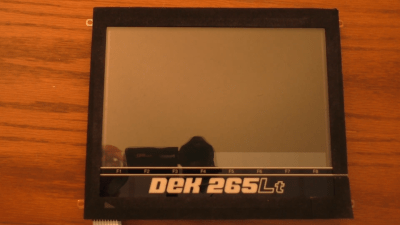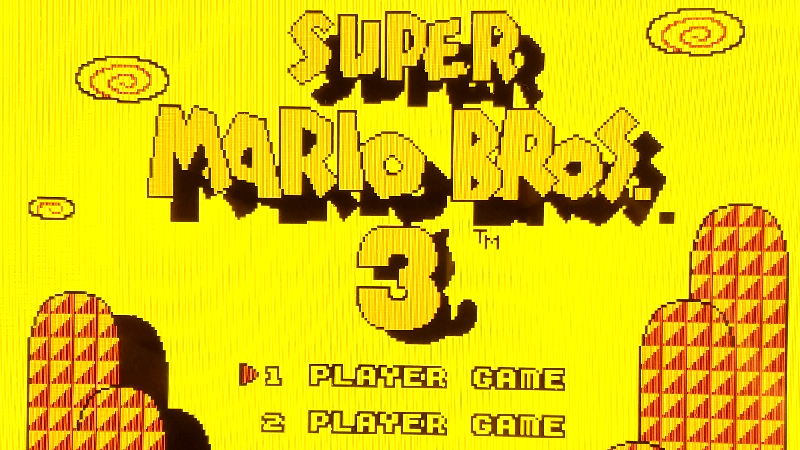Modern consoles are fun, but there are certain charms to retro gear that keep hackers entertained to this day. The original NES is a particularly ripe ground for projects, being one of the most popular consoles of its era. [kevtris] is one such Nintendo hacker, and decided to get NES games running on an old-school electroluminescent display (Youtube video, embedded below).

Rather than work with an original NES, [kevtris] chose to instead work with the NT Mini, an FPGA-based clone of his own design. Having picked up an EL640.480-AA1 screen, formerly from a DEK 265LT pick-and-place machine, he hunted down a data sheet and got to work. With the document outlining the required video input specifications, it was a simple matter of whipping up some Verilog and an adapter cable to get things working.
Mario, Kirby and friends can now run around, looking resplendent in the 9 colors of the red/green EL display. [kevtris] notes that the screen performs well with fast motion, and estimates the refresh rate to be in the vicinity of 60Hz. For those of you playing along at home, such screens are available online, though they’re not exactly cheap.
We’ve seen [kevtris]’s work before, with his SNES chiptune player being particularly impressive. Video after the break.
[Thanks to Morris for the tip!]















That’s a hell of a lot of work to give Mario jaundice!
It pains me when you all say “it was a simple matter of whipping up some Verilog” , i’ve been trying to absorb that for 5 years and still fail.
Note the $3k price tag for a new unit is a bit misleading. They can be bought used on eBay for $100-$300. Still not cheap, but at least within reach if you’re determined to mess with one.
Well, I’ve been working for DEK for 16 years(now a part of ASM), and I don’t recall the company ever manufacturing a pick and place machine.
Solder Paste printers, yes.
FYI, a DEK 265Lt is not a PicknPlace machine but rather a light duty (hence Lt) screen printer based on the very successful Dek 265 series of printers. Dek 265 or Dek 265Lt screen printers were very popular on SMT lines in the 90s and 2000s. (my second employer had 6 when I was there, ’95-’99). The DEK265 means a lot to me because it gave me my entrance into engineering. I was a lead operator for 4 SMT lines and the Engineering manager gave me a shot at an Engineering Technician position by sending me to the week long DEK265 maintenance class in Milipitas, CA in 1995. He said if I did well, I would have a promotion waiting for me when I got back. The 5th day included an exam and I aced it. Been in Engineering with PCBA manufacturing ever since. Still close friends with that manager as well.
Interesting Facts: The DEK265 opens up for maintenance/Stencil cleaning by lifting the top half of its head unit, hinged from the back. Since this creates a serious injury risk to the user, there is a spring loaded device that needs to be inserted into the opening to prevent the head from being able to come down on the user. If you Google images of the Dek 265, you can see this as a red stick like object mounted sideways to the front of the machine. Most operators (including myself at the time) called this the Tonya Harding Stick.
The sad part of this device is that the idea was taken from early Fuji GSP-II printers (what I ran at HP in the ’90s) which did not have something like this originally. The GSP-II also lifted a portion of its head unit as well. Unfortunately, it took the suffocation of an equipment technician between the upper and lower head units for Fuji to realize this was a major safety risk that must be addressed. They immediately retrofitted all units in the field with a similar bar that was strong enough to stop the upper unit from lowering. If you Google images for Fuji GSP-II, you can see the bar in the right hand side of the inside; it is Fuji creme colored and looks as though it is bent to the left about 2/3 of the way up. When they did the retrofit at HP, I was only 21 so it scared the hell out of me to realize I could have been killed by the machine I ran every day (lifted the head occurred 10-20 times a day depending on what PCBAs we were building). I figured the worst it could do was sprain my wrist maybe.
Oh yeah, another fun fact. The DEK 265Lt ran on DOS 6.22
Why were they using el displays on these machines rather than LCD or CRT?
Because they work over a large temperature range and have a large viewing angle. Also used in many military and marine cases.